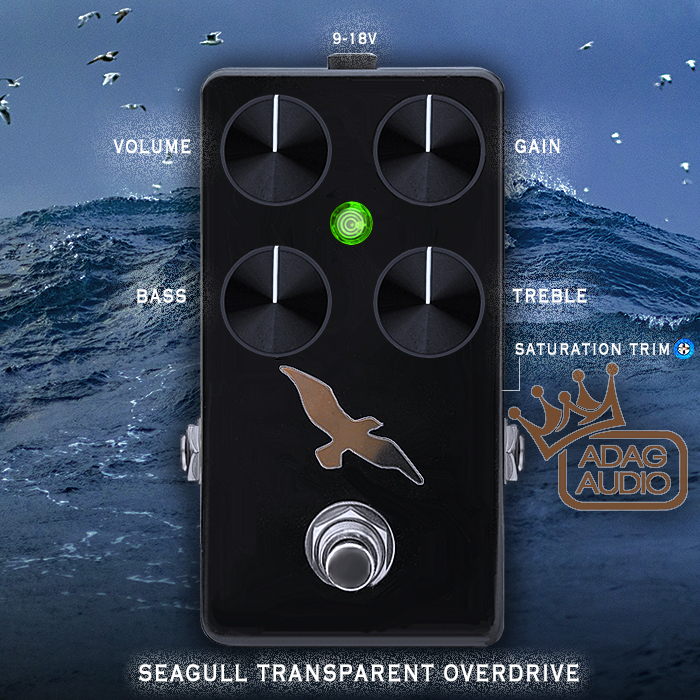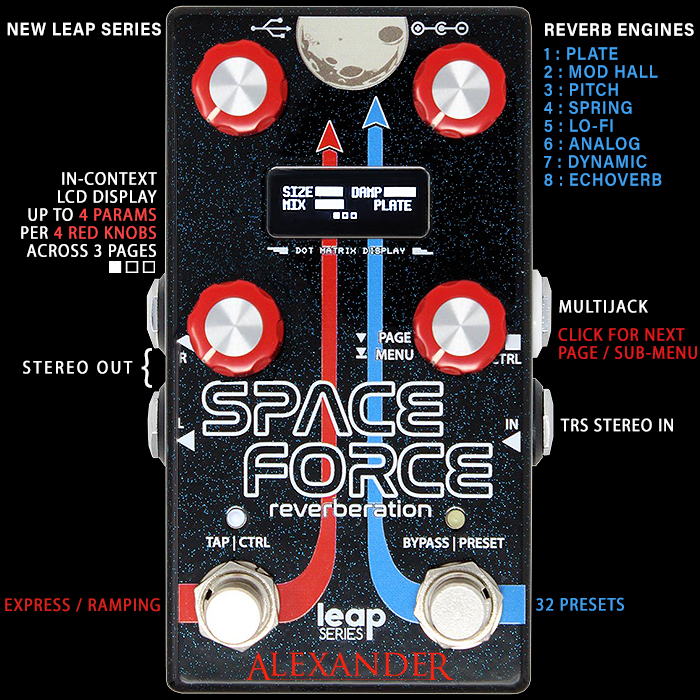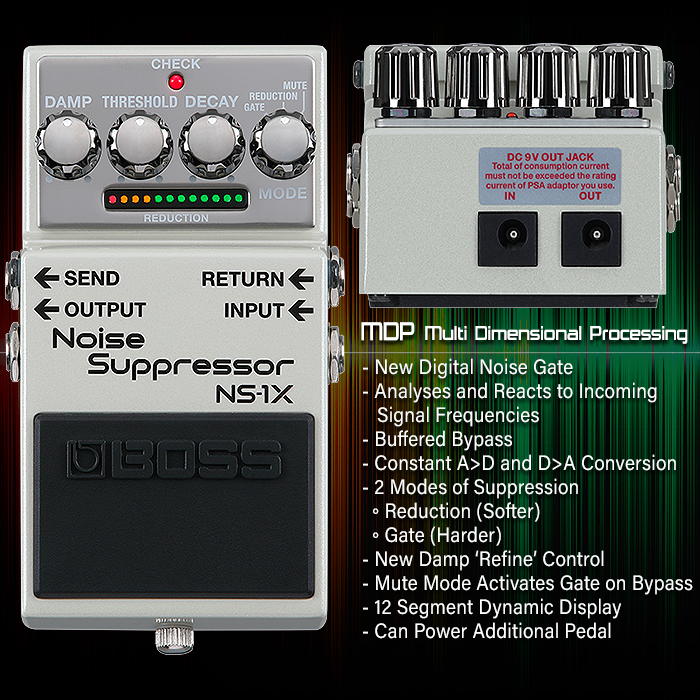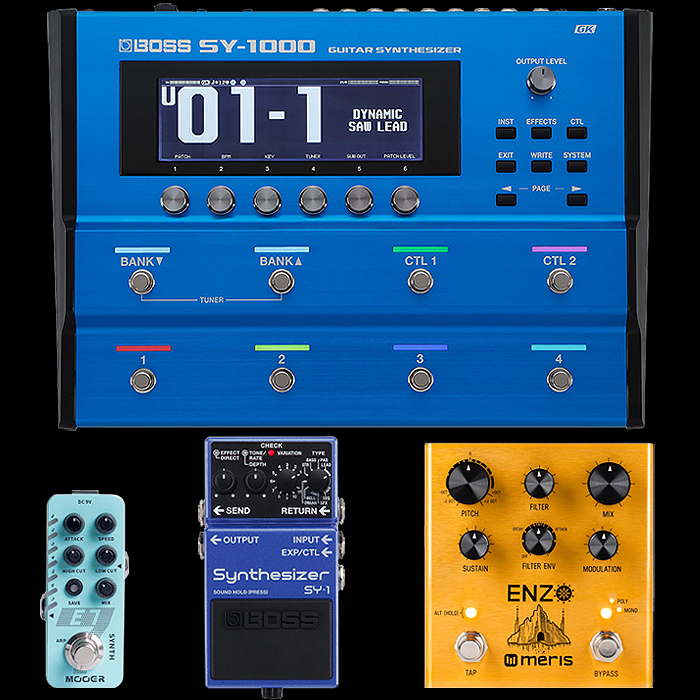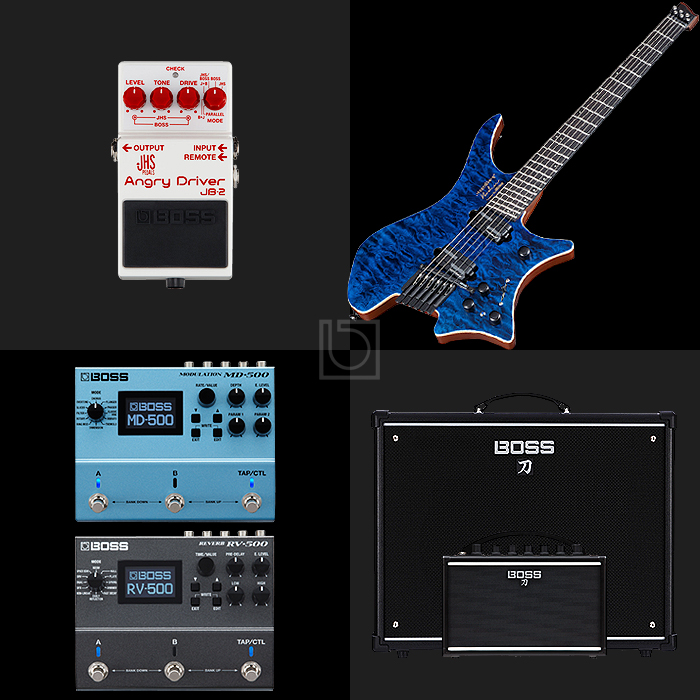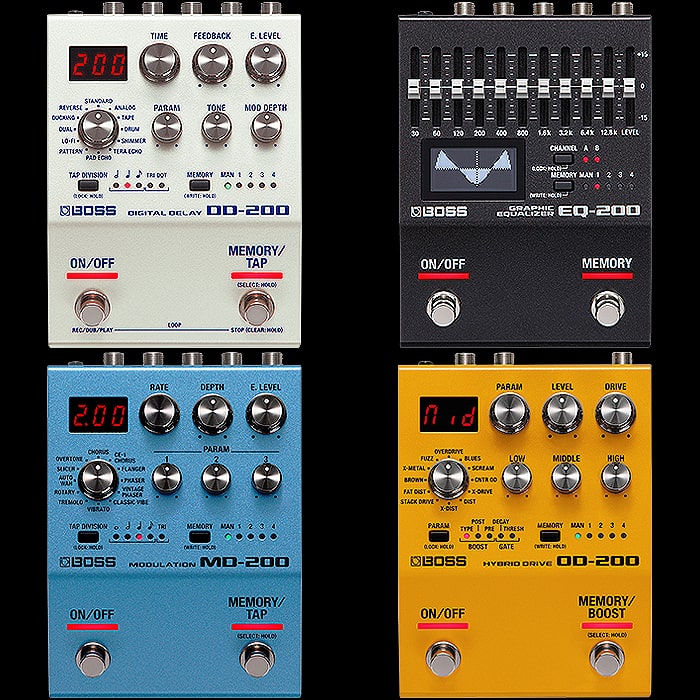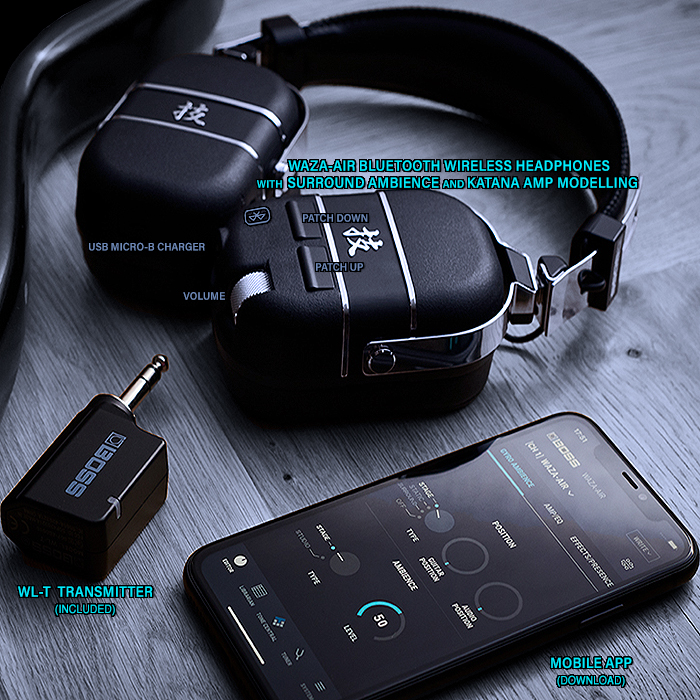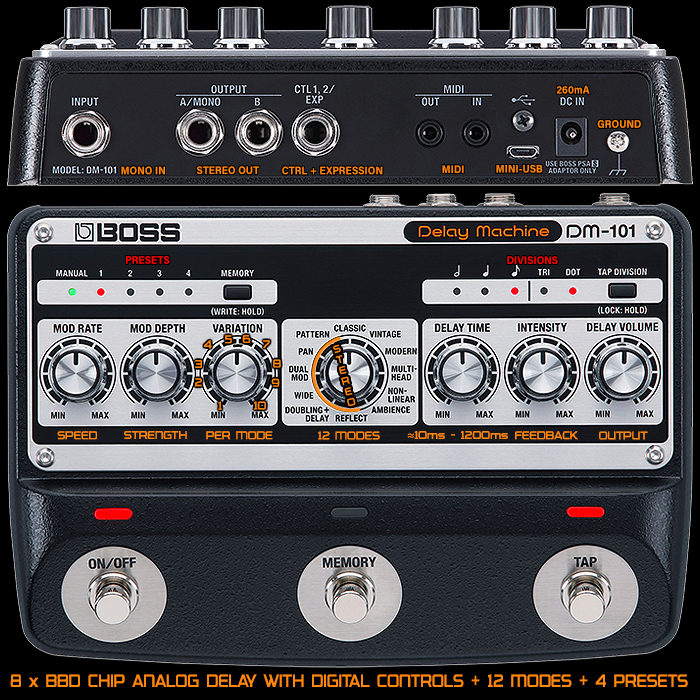Boss RV-500 vs Strymon BigSky - including full list of RV-500 Presets

I’ve had the new big box Boss Reverb for longer than the MD-500 modulation equivalent (even though that review appeared earlier) - it needs to be noted that it has a significantly higher learning curve than the latter pedal, and it’s taken me this long to get fully to grips with it and really understand what all (most of) the different settings do.
The trickiest part for me was figuring out the assignment of the 3rd CTL/TAP footswitch - which really has a vast number of different configurable states and functions. With a little help from Oliver Davis at Roland/Boss - I was able to get over the line.
I’ve stated regularly that I am a big Strymon fan, and did rock the Stryfecta of - Mobius, TimeLine and BigSky for a considerable while. But all of those have now been unseated by more modern and powerful technologies now. You should already have read the head-to-heads on the TimeLine and Mobius. this piece completes and concludes the Stryfecta trilogy. All 3 Strymon pedals still remain excellent and viable alternatives, and I will be keeping them for mixing things up ongoingly as well as for further musical exploration and experimentation.
It has to be said though that the Boss pedals give you a lot more bang for your buck while still sounding fantastic in their own way. As I reported with the MD-500, the default tone for Boss tends to be more flat / neutral, while the Strymons are somewhat mellifluously tuned to accentuate and dampen certain key frequencies for a magical sweet-spot tonality. You can by all means achieve similar with the Boss pedals, but you do need to dial that in.
Rabea's RV-500 Demo / Review
As with the MD-500, it was Rabea's demo that really swung the decision for me. I had heard some whispers on YouTube - possibly just trolls, that the 'Spring' algorithm on the Boss was horrible and unusable - I find no evidence of that - in fact I can tune in a really great twangy and drippy style 60's surf spring reverb tone. You may still prefer the tone of the Strymon BigSky Spring algorithm and of course that is your own prerogative and preference. I'm not really an authority on the authenticity of digital spring reverbs, but to my ears the Boss RV-500's spring mode sounds totally darn fine, as are all its other algorithms.
This pedal is obviously inspired by and evolved from the Strymon mould, while the screen, menu system and controllability elevate it further. As with the MD-500 pedal, one of the key reasons to acquire this particular one is the mulitple effect routing options and the ability to play two reverbs simultaneously, each with its own complementary delay, and split left/right in stereo.
This pedal is a whole other degree of complexity than the Strymon BigSky, but the menu system and bigger screen of the Boss - makes it all much more doable and dial-able. I never found the BigSky menu system quite as intuitive or transparent. There are for certain parts of the Boss which are still quite obtuse, and I feel that some of the documentation is rather inadequate and unhelpful.
There's no doubt for me though that the Boss RV-500 is THE most state-of-the-art reverb pedal currently available - and allows you to do things no other reverb pedal can. It beats the much hyped Source Audio Ventris to the punch, and will likely still have more onboard than the latter when it finally sees the light of day this month or next.
The combination of dual reverb + dual delay + stereo split, smart display and menu and clever control options - makes this the current front-runner by some distance. It also sounds fabulous to me, and is significantly lower cost than the Strymon BigSky. There are certain algorithms which are unique to each pedal, and the BigSky still holds its own for several of those. In overall power, versatility and straight-up usability, the Boss RV-500 is the winner.
The Strymon 'Sweet Spot'
Exactly as I referenced in the previous MD-500 vs Strymon Mobius head-to-head review, Strymon's advantage has always been in its lush and pristine default tones. The Strymon engineers do something magical to their tone-stack - using high and low-cut filters to temper and smooth out unruly high frequencies and fluttery or distorted bass. The sound is slightly warmed up and ever so subtly 'enhanced'.
What this means is that you can feed almost anything into a Strymon pedal and it will rarely if ever sound harsh - even for quite heavy saturation and distortion. By contrast most other modulation pedals require some degree of frequency tampering to tame the more unruly outlier frequencies.
As I also said in my previous MD-500 piece - as long as you know what you're working with you, can react and adjust appropriately. This may mean you spend a little more time dialling in your perfect Boss preset - but you have more options, a better screen and a better menu system to get you there.
Functionality Head-to-Head
Both these pedals are amazing and do provide roughly the same thing - they have the 7 more obvious reverb types in common, while each has 5 sort of unique algorithms of its own. Funnily enough I already have a Space Echo algorithm in my EchoSystem pedal, but the Boss version is superior, and is one of my most used ones on the RV-500. My default go-to tends to be the Fast Decay - which does not interfere with your playing at all, but I really like the dubby-ness of the Space Echo. My other favourites on the Boss are the various SFX modes and the highly atmospheric SRV modes.
The modes I miss most from the Strymon are the Cloud and Chorale in particular - I used to refer to the latter as 'celestial' or 'angelic' mode. Other than that, both pedals pretty much overlap. You can get Swell and Bloom -style reverbs out of the Boss relatively easily. While Strymon's Magneto is not a million miles from the Space Echo - I somehow never used it that much on that pedal. There is no doubt that both of these are inspiration machines with the very best reverb tones available anywhere. It is totally understandable how many still rank the BigSky as the best reverb pedal of all time - it still sounds amazing, it's just that the Boss goes quite a bit further in several departments.
RV-500 vs BigSky
Matching = 7
- Room = Room
- Hall = Hall
- Plate = Plate
- Spring = Spring
- Shimmer = Shimmer
- Early Reflection = Reflections
- Non-Linear = Nonlinear
Unique to RV-500
- Fast Decay - This is my go-to algorithm for default playing - works with any kind of input, no matter how distorted or saturated
- SFX (Lo-Fi | SlowVerb | Storm) - I use the SlowVerb mostly here for kind of Swell / Bloom style reverbs, not yet so much of the Lo-Fi and Storm
- Dual - Ability to run 2 Reverbs simultaneously, not the same as the A/B split mode - here you are limited to Room, Hall, Plate or Spring, while the A/B simultaneous mode give you the choice of any algorithm / preset - even 2 x Dual Reverb!
- SRV (Roland SRV-2000 : Room | Hall | Plate) - Classic Roland Studio Multi-Dimension Stereo Rack Reverb
- Space Echo (Roland RE-201) - 3-head tape delay plus reverb classic
Unique to BigSky
- Swell - Your typical slow build-up reverb, nor dissimilar to the Boss's SlowVerb
- Bloom - A unique kind of feedback fed type of swell - with smoothing off as well as build-up
- Cloud - A really subtle but effective ambient mode - not a million miles from a bloom, but more slurry and hazy sort of
- Chorale - This is a kind of formant type reverb using vocal-like underpinnings to create a choir of angels type soundscape - or something a little more sinister
- Magneto - This is a multi-tape-head echo plus reverb, not entirely dissimilar to the Space Echo
6 Areas where the RV-500 wins it
Because of Boss's newer technology, much like a newer generation of mobile phones, it obviously should have numerous advantages over its predecessors, and it really does here. Not all of them are necessarily visible or audible. Boss's superior internals - 32-bit AD/DA, 32-bit floating point processing, and 96 kHz sampling rate obviously put it above the the Strymon BigSky in terms of base-level processing power, meaning you should get a more pristine signal / output from the Boss. Despite that, the Strymon BigSky is cleverly tuned within its tone stack, meaning that you often cannot hear any obvious or distinct differences in fidelity.
I have therefore focused on the clearer and more tangible advantages that the Boss has:
- A/B Simul Mode - activate 2 effects simultaneously in series or parallel, e.g. a Space Echo on the Left Channel, and a Shimmer on the Right
- Complementary Delay - You can exactly configure a modulated delay to accompany each Reverb, making for a sum total of 4 simultaneous stereo-split effects - 2 Reverbs with 2 Delays. It does not mean you can entirely do without a delay pedal, but you often don't need it
- Better Display - The Boss has a much better and more detailed screen - much easier to see what's supposed to be happening
- Easier Menu System - more options, but easier to drill down, edit and save than on the BigSky
- More Granularity - All manner of fine-tuning settings are at your disposal, sometimes a little bit option paralysis though
- More configurability of footswitches - You can configure how foowswitches work in a variety of ways - can be a little tricky, but gives you amazing controllability
Those are all clear advantages the RV-500 has over the Strymon BigSky.
The disadvantages are largely the same also as per the MD-500 vs Mobius - namely that the Boss enclosure is very slightly larger than the Strymon, and does not have quite the same pristine quality feel - particularly in the area of its plastic dials and switches (versus the milled aluminium of the Strymon). The Boss Enclosure feels robust, but the dials and in particular the edit switches are made of cheap and brittle plastic. I don't mind that they're plastic so much, but in the same way that German cars have the best dashboard, panel and switch plastics compared to most of their competitors, Boss could have similarly used better plastics here. It kind of lowers the overall tone just a smidgen. All the dials and switches though perform well and are crisp and accurate - which indicates very solid and high-quality internals, pots etc.
There are two different degrees of complexity here too - I never really liked the menu system of the Strymon - yes it has fewer settings than the Boss, but getting to them is more obscure and I don't really like the hugely limiting Strymon LED displays, and how settings appear on them.
For the Boss RV-500 there is a lot to get your head around, particularly the interplay between Patch, Control and Assign. The first bank of settings allows you to configure all the Reverb and Delay parameters, the Control is a bank of just 8 settings fields - which allows you to set Hold, Twist, Warp, Tap mode etc. for the CTL/TAP footswitch. But then there is the very complicated Assign bank of settings where you can target no less than 110 Reverb and Delay parameters to the CTL/TAP footswitch - define if the 3rd footswitch is default On or Off, and what parameter's it triggers. It is mostly used for Delay Input Level - so you can switch on and off the Delay part, but you can have any of the 110 key parameters actioned here, and set to either default on or off - which in itself is amazing, but take a while to fully figure out. The essentially 28 page manual is totally inadequate at explaining any of this, and there are no further training materials, PDFs or videos available to instruct you on really how to get the best out of this pedal - I had to learn the hard way - by pure A/B experimentation and documenting personally a lot of the settings parameters.
This is my only major bugbear with Boss really, in an age of Strymon, Empress and Chase Bliss - who all provider excellent support and training materials, that the world's biggest pedal builder should be so far off the pace. I really don't understand why Boss cannot commission someone to do better / additional training and support materials for its pedals. And while you can learn the MD-500 pretty much entirely on your own, I really struggled with the RV-500 for a while, and found the Manual often wanting in properly explaining how things worked.
In fact this blog post is written in part to share the 60 RV-500 factory presets, which Boss were also unable to furnish me with. Hopefully at least some of you will benefit from my discoveries:
Complete List of Boss RV-500 Presets
Note that the Strymon BigSky contains 100 pre-configured factory presets with a total possible user-configurable ones at 300. The Boss has 60 factory presets with a maximum range of 200. There are pros and cons in the number of preset options, I find overall the fewer Boss ones are more usable than the BigSky ones as previously reported. I find myself pretty much using all the different effect modes available rather than just mostly 7 or 8 main ones - which was sometimes the case with the BigSky. Of course there will be some that prefer the overall effects modes on the Strymon, while I am now very firmly in the Boss camp in this area - I do though really miss 'Chorale'. But overall for me the RV-500 modes pip the BigSky (just). I can totally understand for seasoned session players who have spent years building up their Strymon preset libraries, that a move to Boss would be a big ask. For most everybody else though there are numerous benefits in going Boss here.
Boss RV-500 Presets by Patch Number
* : LED ON = CTL / secondary effect is typically ON by default
01A - Hall Reverb [Hall]
01B - Studio Reverb [Room]
02A - Large Plate [Plate]
02B - Adventure [Spring : 2]
*03A - Symphony [Shimmer]
03B - Fast Decay [Fast Decay]
04A - Roomy Reflection [Early Reflection]
*04B - Gated [Non-Linear : Gate]
05A - Swell a Note [SFX : SlowVerb]
*05B - Lo-Fi Reverb [SFX : Lo-Fi]
06A - Windy Land [SFX : Storm]
*06B - Metallic Hall [Dual : Hall + Plate]
07A - SRV Room [SRV : Room R22]
07B - Cheesy Tape [Space Echo : 1+2 heads]
*08A - Cloudy Sky [Room]
08B - Technical Suite [Room]
09A - Room Ambience [Room]
09B - Wooden Room [Room]
10A - Arena [Hall]
*10B - Raining [Hall]
*11A - Ducking Plate [Plate]
11B - Bended [Plate]
12A - Blues Spring [Spring : 2]
12B - Low Tension [Spring : 1]
13A - Light Tunnel [Shimmer]
*13B - Ducking Shimmer [Shimmer]
14A - Long Tail [Fast Decay]
14B - Desert Hill [Fast Decay]
*15A - Slapback ER [Early Reflection]
15B - Para Para [Early Reflection]
16A - Non-Linear Verb [Non-Linear : Non-Linear]
16B - Climbout [Non-Linear : Reverse]
*17A - Moonlight [SFX : SlowVerb]
*17B - Morning Glory [SFX : SlowVerb]
18A - Concord [Dual : Room + Room]
18B - Picking [Dual : Hall + Hall]
19A - SRV Plate [SRV : P-A]
*19B - SRV Hall [SRV : H37]
20A - Multi Slap [Space Echo : 3 heads]
20B - Bleeding [Space Echo : 3 heads]
21A - Ringer [Plate]
21B - Sparkling [Plate]
22A - Reverb Reverb [Plate]
22B - 3 Heads [Space Echo]
23A - Gig Ready [Room]
23B - Dungeon [Hall]
24A - Bad Morning [Early Reflection]
24B - Time-Slip [Hall]
25A - Waftage [Shimmer]
25B - Chasing [SFX - SlowVerb]
26A - Nice Hall [Hall]
26B - Plate & Spring [Dual]
27A - Choral Society [Room]
27B - Endless [Hall]
28A - Good Luck [Room]
28B - Brightness [Hall]
29A - Cathedral [Shimmer]
29B - Stardust [Hall]
30A - Cold Rain [Shimmer]
30B - Falling Down [Shimmer]
Boss RV-500 Presets by Effect Mode
* = LED ON = CTL / secondary effect default is usually ON
Room [Ambience | Small | Medium | Large]
() Pre-Delay | () Efect Level
() High | () Low
01B - Studio Reverb [Room] (Medium : CTL = Delay Input Level > On when LED On, LED Default Off)
*08A - Cloudy Sky [Room] (Large : CTL = Delay Input Level > On when LED On, LED Default ON)
08B - Technical Suite [Room] (Medium : CTL = Hold - Momentary)
09A - Room Ambience [Room] (Ambience : CTL = Delay Input Level > On when LED On, LED Default Off)
09B - Wooden Room [Room] (Small : CTL = Warp - Momentary)
23A - Gig Ready [Room] (Large : CTL = Delay Input Level > On when LED On, LED Default Off)
27A - Choral Society [Room] (Large : CTL = Hold - Momentary)
28A - Good Luck [Room] (Large : CTL = Twist - Momentary)
Hall [Small | Medium | Large]
Same - P-Dly | E-Lvl | Hi | Lo - dial controls
01A - Hall Reverb [Hall] (Medium : CTL = Delay Input Level > Off when LED On, LED Default Off)
10A - Arena [Hall] (Large : CTL = Hold - Momentary)
10B - Raining [Hall] (Medium : CTL = Delay Input Level > On when LED On, LED Default Off)
23B - Dungeon [Hall] (Large : CTL = Hold - Momentary)
24B - Time-Slip [Hall] (Large : CTL = Twist - Momentary)
26A - Nice Hall [Hall] (Medium : CTL = Hold - Momentary)
27B - Endless [Hall] (Large : CTL = Hold - Momentary)
28B - Brightness [Hall] (Large : CTL = Twist - Momentary)
29B - Stardust [Hall] (Large : CTL = Hold - Momentary)
Plate [No specific type settings or TRG targeting]
Same - P-Dly | E-Lvl | Hi | Lo - dial controls
02A - Large Plate [Plate] (CTL = Delay Input Level > On when LED On, LED Default Off)
*11A - Ducking Plate [Plate] (CTL = Duck Sensitivity > On when LED ON, LED Default ON)
11B - Bended [Plate] (CTL = Hold - Momentary)
21A - Ringer [Plate] (CTL = Delay Input Level > On when LED On, LED Default Off)
21B - Sparkling [Plate] (CTL = Hold - Momentary)
22A - Reverb Reverb [Plate] (CTL = Warp - Momentary)
Spring [Spring Number 1-3]
Same - P-Dly | E-Lvl | Hi | Lo - dial controls
02B - Adventure [Spring] (2 Springs : CTL = Delay Input Level > On when LED On, LED Default Off)
12A - Blues Spring [Spring] (2 Springs : CTL = Delay Input Level > On when LED On, LED Default Off)
12B - Low Tension [Spring] (1 Spring : CTL = Twist - Momentary)
Shimmer [1+2 Pitch | Fine | Release | Level]
Same - P-Dly | E-Lvl | Hi | Lo - dial controls
*03A - Symphony [Shimmer] (CTL = Shimmer Level 1 > On when LED On, LED Default ON)
13A - Light Tunnel [Shimmer] (CTL = Hold - Momentary)
*13B - Ducking Shimmer [Shimmer] (CTL = Ducking Sensitivity > On when LED On, Led Defaul On)
25A - Waftage [Shimmer] (CTL = Hold - Momentary)
29A - Cathedral [Shimmer] (Totally Wet : CTL = Hold - Momentary)
30A - Cold Rain [Shimmer] (CTL = Hold - Momentary)
30B - Falling Down [Shimmer] (CTL = Twist - Momentary)
Fast Decay [Decay 1-10]
Same - P-Dly | E-Lvl | Hi | Lo - dial controls
03B - Fast Decay [Fast Decay] (CTL = Delay Input Level > On when LED On, LED Default Off) [Note - this is current favourite default preset!]
14A - Long Tail [Fast Decay] (CTL = Hold - Momentary)
14B - Desert Hill [Fast Decay] (CTL = Twist - Momentary)
Early Reflection [Type 1-4 | Envelope 1-10]
Same - P-Dly | E-Lvl | Hi | Lo - dial controls
04A - Roomy Reflection [Early Reflection] (CTL = Delay Effect Level > On when LED On, LED Default Off)
*15A - Slapback ER [Early Reflection] (CTL = Delay Input Level > On when LED On, LED Default ON)
15B - Para Para [Early Reflection] (CTL = Delay Effect Level > On when LED On, LED Default Off)
24A - Bad Morning [Early Reflection] (CTL = Hold - Momentary)
Non-Linear [Gate | Non-Linear | Reverse]
Same - P-Dly | E-Lvl | Hi | Lo - dial controls
*04B - Gated [Non-Linear] (Gate : CTL = Gate Threshold > On when LED On, LED Default ON)
16A - Non-Linear Verb [Non-Linear] (Non-Linear : CTL = Twist - Momentary)
16B - Climbout [Non-Linear] (Reverse :CTL = Hold - Momentary)
SFX [Lo-Fi | SlowVerb | Storm]
Same - P-Dly | E-Lvl | Hi | Lo - dial controls
05A - Swell a Note [SFX] (SlowVerb : CTL = Twist - Momentary)
*05B - Lo-Fi Reverb [SFX] (Lo-Fi : CTL = Delay Input Level > On when LED On, LED Default ON)
06A - Windy Land [SFX] (Storm : CTL = Twist - Momentary)
*17A - Moonlight [SFX] (SlowVerb : CTL = SlowVerb Rise Time > On when LED On, LED Default ON)
*17B - Morning Glory [SFX] (SlowVerb : CTL = Direcl Level > On when LED On, LED Default ON)
25B - Chasing [SFX] (SlowVerb : CTL = Delay Input Level > On when LED On, LED Default Off)
Dual [Room | Hall | Plate | Spring]
Same - P-Dly | E-Lvl | Hi | Lo - dial controls
*06B - Metallic Hall [Dual] (Hall + Plate : CTL = Dual Effect Level 2 > On when LED On, LED Default ON)
18A - Concord [Dual] (Room + Room : CTL = Dual Time 2 > On when LED Off, LED Defaul Off)
18B - Picking [Dual] (Hall + Hall : CTL = Hold - Momentary)
26B - Plate & Spring [Dual] (Plate + Spring : CTL = Hold - Momentary)
SRV [Roland SRV-2000 : Plate P-A/B | Hall H15-37 | Room R0.3-37]
Same - P-Dly | E-Lvl | Hi | Lo - dial controls
07A - SRV Room [SRV] (R22 : CTL = Delay Input Level > On when LED On, LED Default Off)
19A - SRV Plate [SRV] (P-A : CTL = Delay Input Level > On when LED On, LED Default Off)
*19B - SRV Hall [SRV] (H37 : CTL = Delay Input Level > On when LED On, LED Default ON)
Space Echo [Roland RE-201 : 1-3 Tape Heads | Repeat Rate | BPM | Subdivisions]
Same - P-Dly | E-Lvl | Hi | Lo - dial controls
07B - Cheesy Tape [Space Echo] (1+2 Tape Heads : CTL = Tap Tempo)
20A - Multi Slap [Space Echo] (1+2+3 Tape Heads : CTL = Tap Tempo)
20B - Bleeding [Space Echo] (1+2+3 Tape Heads : CTL = Tap Tempo)
22B - 3 Heads [Space Echo] (1+2+3 Tape Heads : CTL = Tap Tempo)









